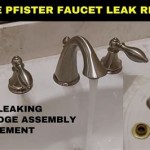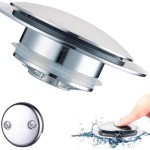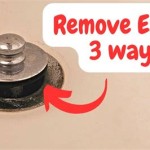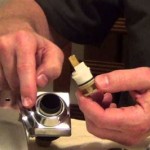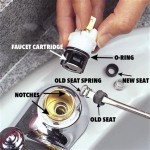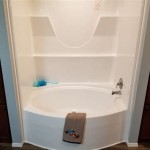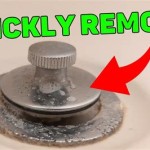Best Ways to Clean a Bathtub Drain Clogged With Hair
A clogged bathtub drain is a common household problem, frequently caused by the accumulation of hair. This obstruction can lead to slow drainage, unpleasant odors, and, if left unaddressed, potential damage to the plumbing system. Effective cleaning methods are essential to maintain a functional and hygienic bathroom environment. This article explores various techniques to address a hair-clogged bathtub drain, ranging from simple DIY solutions to more advanced methods.
The insidious nature of hair in drains stems from its ability to intertwine and bind with other debris, such as soap scum and grease. This forms a dense mass that restricts water flow. Further exacerbating the issue is the tendency of hair to adhere to the rough surfaces within the drainpipe, creating a nucleus for further accumulation. Regular maintenance and preventative measures are crucial to minimizing the likelihood of clogs and ensuring smooth drainage.
Preventative Measures: The First Line of Defense
Before delving into specific cleaning techniques, it's important to emphasize the significance of preventative measures. These proactive steps can significantly reduce the frequency and severity of hair-related drain clogs, saving time, effort, and potentially costly plumbing repairs.
One of the most effective preventative measures is the installation of a drain strainer or hair catcher. These devices are designed to trap hair and other debris before they enter the drainpipe. Strainers are typically inexpensive and easy to install, fitting directly over the drain opening. Numerous types are available, ranging from fine-mesh screens to more elaborate designs with removable baskets. Regularly emptying the strainer of accumulated hair is essential to maintain its effectiveness. This simple habit can dramatically reduce the amount of hair that reaches the drainpipe, preventing clogs from forming in the first place.
Another useful preventative measure involves minimizing the amount of hair that goes down the drain during bathing or showering. This can be achieved by brushing hair thoroughly before showering or bathing to remove loose strands. Consider using a designated container or wastebasket to collect hair that falls out during grooming activities, rather than allowing it to wash down the drain. These small adjustments can collectively contribute to a significant reduction in the amount of hair entering the plumbing system.
Regular flushing of the drain with hot water can also help prevent the buildup of hair and other debris. Hot water helps to dissolve soap scum and loosen any accumulated material, allowing it to be flushed away. This practice is particularly beneficial after showering or bathing, when hair and soap residue are most likely to be present. While hot water is generally effective for preventative maintenance, it's important to avoid using boiling water, especially in pipes made of PVC, as extreme temperatures can potentially damage the plastic.
DIY Cleaning Methods: Simple Solutions for Minor Clogs
When a clog does occur, several DIY methods can be employed to address the problem. These solutions often involve readily available household items and require minimal tools, making them a convenient first approach for minor clogs.
The use of a wire coat hanger is a classic and often effective DIY method. Straighten the coat hanger as much as possible, leaving a small hook at the end. Carefully insert the hooked end of the wire into the drain opening and probe around to locate the clog. Once located, attempt to hook and pull out the accumulated hair and debris. It's crucial to exercise caution to avoid pushing the clog further down the drainpipe. After removing as much debris as possible, flush the drain with hot water to clear any remaining residue. This method is particularly effective for clogs located near the drain opening.
Another popular DIY solution involves a combination of baking soda and vinegar. This method leverages the chemical reaction between these two substances to break down the clog. Begin by pouring one cup of baking soda down the drain, followed by one cup of vinegar. Allow the mixture to fizz for approximately 30 minutes. The bubbling action helps to loosen and dislodge the clog. After 30 minutes, flush the drain with hot water. This process can be repeated if necessary. The baking soda and vinegar method is a relatively gentle approach that is less likely to damage pipes compared to harsh chemical drain cleaners. It is most effective for clogs composed primarily of organic material, such as hair and soap scum.
The use of a plunger is another common DIY method for clearing clogged drains. Ensure that there is enough water in the bathtub to cover the plunger cup. Place the plunger over the drain opening, creating a tight seal. Push and pull the plunger up and down vigorously for several minutes. The pressure created by the plunger can dislodge the clog and allow it to be flushed away. Remove the plunger periodically to check if the water is draining. Repeat the process until the drain is clear. It is important to use a plunger specifically designed for drains, as toilet plungers have a different shape and are less effective for clearing drain clogs.
Advanced Cleaning Methods: Tackling Stubborn Clogs
When DIY methods prove ineffective, more advanced cleaning techniques may be required. These methods often involve specialized tools or chemicals and should be used with caution, following the manufacturer's instructions carefully.
The drain snake, also known as a plumber's snake, is a flexible tool designed to reach deep into the drainpipe and break up or retrieve clogs. A drain snake typically consists of a long, flexible cable with a corkscrew or auger at the end. Insert the snake into the drain opening and advance it through the drainpipe until it encounters the clog. Rotate the snake to break up the clog or to hook and pull it out. Remove the snake carefully, cleaning off any debris that is attached. Flush the drain with hot water to clear any remaining residue. Drain snakes are available in various lengths and thicknesses, allowing them to be used for different types of drains and clogs. When using a drain snake, it is important to avoid forcing it, as this can potentially damage the drainpipe.
Chemical drain cleaners are a readily available option for clearing clogged drains. These products typically contain harsh chemicals that dissolve or break down the clog. While chemical drain cleaners can be effective, they should be used with caution. They can be corrosive and can potentially damage pipes, especially if used repeatedly. It is essential to follow the manufacturer's instructions carefully and to wear appropriate safety gear, such as gloves and eye protection. Avoid mixing different types of drain cleaners, as this can create dangerous fumes. Chemical drain cleaners are best suited for clogs that are difficult to reach using other methods. It is important to consider the potential environmental impact of chemical drain cleaners, as they can contaminate water sources. A safer alternative is enzymatic drain cleaners, which use natural enzymes to break down organic material without harming pipes or the environment.
Another advanced method involves using a wet/dry vacuum to suck out the clog. This method works best when the clog is relatively close to the drain opening. Remove the drain cover and attach a hose to the vacuum. Cover the drain opening tightly with the hose, creating a seal. Turn on the vacuum and attempt to suck out the clog. This method can be effective for removing large clumps of hair and debris. It is important to ensure that the vacuum is designed for wet use, as using a standard vacuum to suck up water can damage the motor.
In cases where all other methods fail, it may be necessary to call a professional plumber. Plumbers have the experience and equipment to diagnose and resolve even the most stubborn drain clogs. They may use specialized tools, such as video cameras, to inspect the drainpipe and identify the location and nature of the clog. Plumbers can also perform more extensive repairs, such as replacing damaged pipes or drain lines. Calling a plumber can be a more expensive option, but it can ultimately save time, effort, and potential damage to the plumbing system, especially in complex situations.

How To Unclog Most Bathtub Drains By Removing Hair

How To Clean Hair Out Of A Shower Drain 9 Easy Ways

5 Easy Ways To Unclog Bathtub Drain

How To Clean Hair Out Of A Shower Drain 9 Easy Ways

How To Clean Hair Out Of A Shower Drain 9 Easy Ways

How To Unclog Bathtub Drain Full Of Hair Stellar Plumbing

How To Easily Unclog Bathtub Shower Drain In 5 Minutes Jonny Diy

Top 5 Ways To Get Hair Out Of Your Drains

How To Unclog A Bathtub Drain Without Chemicals

How To Unclog A Bathtub Drain Without Chemicals Family Handyman
Related Posts

